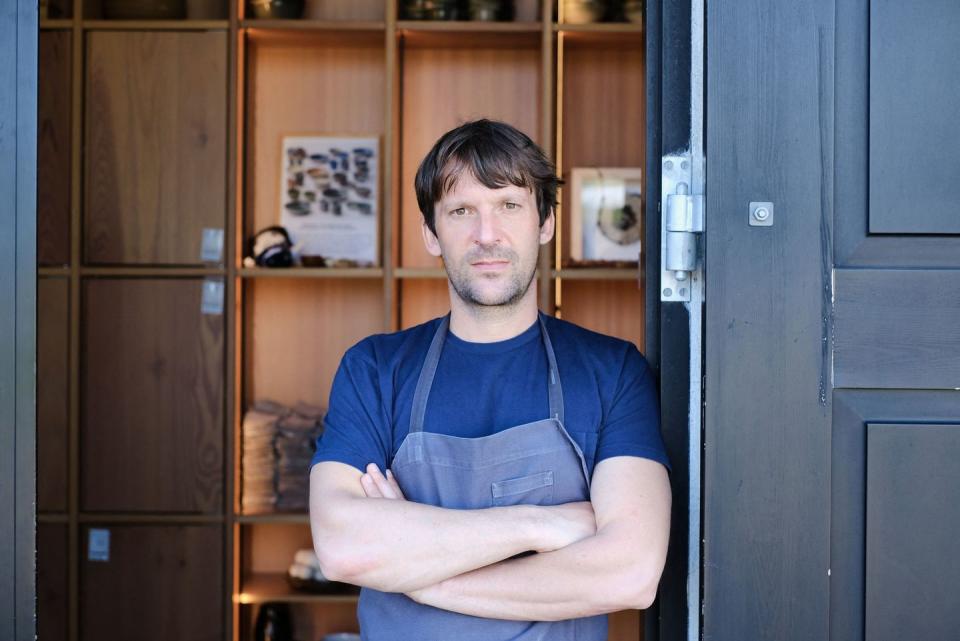When One 3-Star Door Closes, Another Opens

- Oops!Something went wrong.Please try again later.
David Kinch’s decision last November to close Manresa, his three-Michelin-starred Bay Area restaurant, didn’t garner much national attention at first, but then, a few weeks later, René Redzepi announced that Noma, his hugely influential restaurant in Copenhagen, would be closing to the public at the end of 2024. That generated enormous international attention—almost all of which predicted the end of fine dining. Much of the coverage seemed tinged with a certain kind of gleeful moralizing, or in the case of the New York Times’ Frank Bruni, the newspaper’s former restaurant critic, an apology for having once written about this expensive temple of cuisine, and others like it. Suddenly Kinch’s move was being cited as further evidence that the three-star restaurant experience was on the verge of extinction.
I’ve eaten at both Noma and Manresa, and I will miss both restaurants, but I think the whole death-of-haute-cuisine call is premature. So, for that matter, does Kinch. When I called him a couple of days after Redzepi’s announcement, he was clearly annoyed at having his own story shoehorned into the apocalypse story. He’d been contacted by numerous publications. “They only quoted me when it suited the narrative,” he said. The two meals I had at his restaurant last year were among the best I’ve ever eaten anywhere, and not a single dish was repeated on my second visit—no small feat for an eight-course tasting menu. Kinch clearly wasn’t phoning it in. In fact, by his own admission he cranked up the volume at the end. “I think I was cooking better than I ever have these last few months,” he told me when I dined there at the end of December.

“We have to completely rethink the industry,” Redzepi told the New York Times when he made his announcement. “This is simply too hard, and we have to work in a different way.” Much as I admire Redzepi, I think it’s a little grandiose to generalize about the entire industry based on one’s own unique business model. Meals at Noma are often accompanied by labor-intensive decorative flourishes created by stagiaires. The “beetle,” for instance, is constructed out of parts cut from dried sheets of fruit jam that are assembled to look exactly like the insect. How many people will miss it? I know I’m glad I never saw a beetle on my plate. And while the stagiaire system, in which unpaid or low-paid interns perform menial kitchen tasks as a form of apprenticeship, has been a feature of restaurant kitchens since before Escoffier, it has come under deserved scrutiny, particularly since the pandemic. If increasing salaries means fewer beetles on the plate and higher tabs for high-end diners, it’s an excellent trade-off.

“I had a financially responsible business model,” Kinch told me. “I paid my bills and I paid my people and I made money. My decision to leave was personal—it’s been 20 years! But the idea that fine dining is finished is ridiculous. What we’re seeing is the end of gilded lilies and a certain baroqueness. Fine dining’s not going away.”
As if to prove that very point, a few weeks before Manresa closed, chef William Bradley and his team at Addison, in San Diego, were awarded three Michelin stars. Bradley’s cooking, while clearly rooted in classical French technique, incorporates Japanese, Thai, and Mexican influences. The menu is full of playful flourishes, including a dish based on French onion dip (the kind my mom made for parties, with Lipton soup mix) as well as chicken liver churros.

I was impressed when I first visited, five years ago, though I felt that he was still finding his voice. The cooking didn’t quite live up to the drama of its setting: the Mizneresque dining room, with its soaring coffered ceilings, horse-high limestone fireplace, and arched doorways flanked by Corinthian columns. But I was astonished by the wine list, easily one of the best in the country, a novel-length document that featured dozens of trophies and unicorns from France, Italy, and the United States.
In 2019 Addison received its first Michelin star. “At that point,” Bradley told me, “I decided to go all out.” On my last visit, a couple of weeks after the announcement of its third star, I was blown away by the degree to which his vision had developed and coalesced, how bright the flavors were, how the nine-course tasting menu had evolved into a brilliant and rhythmic progression. His caviar, koshihikari rice, smoked sabayon, and sesame was definitely one of my top three dishes of last year, right up there with Kinch’s guinea hen with matsutake mushrooms and onion.
The dramatic setting seemed less overwrought somehow, given the quality of the food—ditto the balletic service. Dishes are dropped simultaneously by a duo or a quartet of servers. I was somewhat astonished when Bradley told me that day that he operated with a staff of 40. I would have guessed at least twice that number. The fact that such a small team can produce such an exemplary experience seems almost miraculous. Maybe Redzepi should visit and see how it’s done.
“We run lean and mean,” he said. Bradley mentioned that he had traveled north to visit Manresa in its final month, and I thought, A torch has been passed.
A version of his story appears in the April 2023 issue of Town & Country. SUBSCRIBE NOW
You Might Also Like

